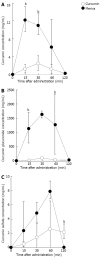Therapeutic potential of curcumin in digestive diseases
- PMID: 24409053
- PMCID: PMC3882399
- DOI: 10.3748/wjg.v19.i48.9256
Therapeutic potential of curcumin in digestive diseases
Abstract
Curcumin is a low-molecular-weight hydrophobic polyphenol that is extracted from turmeric, which possesses a wide range of biological properties including anti-inflammatory, anti-oxidant, anti-proliferative and anti-microbial activities. Despite its diverse targets and substantial safety, clinical applications of this molecule for digestive disorders have been largely limited to case series or small clinical trials. The poor bioavailability of curcumin is likely the major hurdle for its more widespread use in humans. However, complexation of curcumin into phytosomes has recently helped to bypass this problem, as it has been demonstrated that this new lecithin formulation enables increased absorption to a level 29-fold higher than that of traditional curcuminoid products. This allows us to achieve much greater tissue substance delivery using significantly lower doses of curcumin than have been used in past clinical studies. As curcumin has already been shown to provide good therapeutic results in some small studies of both inflammatory and neoplastic bowel disorders, it is reasonable to anticipate an even greater efficacy with the advent of this new technology, which remarkably improves its bioavailability. These features are very promising and may represent a novel and effective therapeutic approach to both functional and organic digestive diseases.
Keywords: Curcumin; Curcumin bioavailability; Curcumin-phythosome; Digestive disorders.
Figures




Similar articles
-
Curcumin: an anti-inflammatory molecule from a curry spice on the path to cancer treatment.Molecules. 2011 Jun 3;16(6):4567-98. doi: 10.3390/molecules16064567. Molecules. 2011. PMID: 21642934 Free PMC article. Review.
-
Curcumin in Hepatobiliary Disease: Pharmacotherapeutic Properties and Emerging Potential Clinical Applications.Ann Hepatol. 2017 November-December,;16(6):835-841. doi: 10.5604/01.3001.0010.5273. Ann Hepatol. 2017. PMID: 29055920 Review.
-
Curcumin (Turmeric) and cancer.J BUON. 2016 Sept-Oct;21(5):1050-1060. J BUON. 2016. PMID: 27837604 Review.
-
Beyond Yellow Curry: Assessing Commercial Curcumin Absorption Technologies.J Am Coll Nutr. 2015;34(4):347-58. doi: 10.1080/07315724.2014.950392. Epub 2015 Apr 9. J Am Coll Nutr. 2015. PMID: 25856323 Free PMC article. Review.
-
A review of therapeutic potentials of turmeric (Curcuma longa) and its active constituent, curcumin, on inflammatory disorders, pain, and their related patents.Phytother Res. 2021 Dec;35(12):6489-6513. doi: 10.1002/ptr.7224. Epub 2021 Jul 26. Phytother Res. 2021. PMID: 34312922 Review.
Cited by
-
Intestinal inflammation and the diet: Is food friend or foe?World J Gastrointest Surg. 2016 Feb 27;8(2):115-23. doi: 10.4240/wjgs.v8.i2.115. World J Gastrointest Surg. 2016. PMID: 26981185 Free PMC article. Review.
-
Effects of a blend of green tea and curcuma extract supplementation on lipopolysaccharide-induced inflammation in horses and ponies.PeerJ. 2019 Nov 12;7:e8053. doi: 10.7717/peerj.8053. eCollection 2019. PeerJ. 2019. PMID: 31741800 Free PMC article.
-
A poly-herbal blend (Herbagut®) on adults presenting with gastrointestinal complaints: a randomised, double-blind, placebo-controlled study.BMC Complement Altern Med. 2018 Mar 20;18(1):98. doi: 10.1186/s12906-018-2168-y. BMC Complement Altern Med. 2018. PMID: 29554961 Free PMC article. Clinical Trial.
-
Chronic Intestinal Disorders in Humans and Pets: Current Management and the Potential of Nutraceutical Antioxidants as Alternatives.Animals (Basel). 2022 Mar 23;12(7):812. doi: 10.3390/ani12070812. Animals (Basel). 2022. PMID: 35405802 Free PMC article. Review.
-
Design, synthesis, and evaluation of curcumin analogues as potential inhibitors of bacterial sialidase.J Enzyme Inhib Med Chem. 2018 Dec;33(1):1256-1265. doi: 10.1080/14756366.2018.1488695. J Enzyme Inhib Med Chem. 2018. PMID: 30126306 Free PMC article.
References
-
- Ammon HP, Wahl MA. Pharmacology of Curcuma longa. Planta Med. 1991;57:1–7. - PubMed
-
- Aggarwal BB, Kumar A, Bharti AC. Anticancer potential of curcumin: preclinical and clinical studies. Anticancer Res. 2003;23:363–398. - PubMed
-
- Kita T, Imai S, Sawada H, Kumagai H, Seto H. The biosynthetic pathway of curcuminoid in turmeric (Curcuma longa) as revealed by 13C-labeled precursors. Biosci Biotechnol Biochem. 2008;72:1789–1798. - PubMed
-
- Balasubramanian K. Molecular orbital basis for yellow curry spice curcumin’s prevention of Alzheimer’s disease. J Agric Food Chem. 2006;54:3512–3520. - PubMed
-
- Priyadarsini KI, Maity DK, Naik GH, Kumar MS, Unnikrishnan MK, Satav JG, Mohan H. Role of phenolic O-H and methylene hydrogen on the free radical reactions and antioxidant activity of curcumin. Free Radic Biol Med. 2003;35:475–484. - PubMed
Publication types
MeSH terms
Substances
LinkOut - more resources
Full Text Sources
Other Literature Sources
Medical
Research Materials
Miscellaneous

